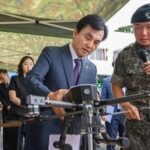North Korea Fires Short-Range Missiles, U.S.-Japan-South Korea Respond with Strong Condemnation
Daniel Kim Views

The defense ministers of South Korea, the U.S., and Japan strongly condemned North Korea’s “reckless acts that are escalating tensions on the Korean Peninsula and in the region,” including the mass launch of short-range ballistic missiles, sending trash balloons to South Korea, and firing GPS jamming signals, following the failure of its military reconnaissance satellite launch.
The South Korea Ministry of National Defense announced on June 2, “meeting at Shangri-La Hotel in Singapore, South Korean Defense Minister Shin Won Sik, U.S. Defense Secretary Lloyd Austin, and Japanese Defense Minister Minoru Kihara held a trilateral defense ministers’ meeting and discussed major issues such as North Korea policy coordination, extended deterrence, and regional security, as they attend to the 21st IISS Asia Security Summit: The Shangri-La Dialogue (SLD).”
In particular, according to the Ministry of National Defense, the three ministers agreed to actively cooperate for the security and peace in the Indo-Pacific region and jointly work for the complete denuclearization of North Korea. The three countries agreed to conduct the Freedom Edge exercise in multiple domains, including cyber, for the first time this summer and to establish a trilateral security cooperation system to institutionalize security cooperation among South Korea, the U.S., and Japan. Earlier, Shin held individual bilateral meetings with Austin and Kihara the previous day and the day, discussing countermeasures against North Korea’s nuclear threat and ways to resolve the radar dispute between the South Korean and Japanese navies.
Shin met with Austin in the morning and clearly stated that North Korea’s launch of a military reconnaissance satellite was an action that blatantly violates the UN Security Council resolution that prohibits the use of ballistic missile technology in cooperation with scientific and technological and threatens the peace and security of the international community.
Both ministers shared the understanding that North Korea’s continuous provocations and the advancement of its nuclear and missile capabilities are the main factors escalating tensions on the Korean Peninsula and in the Indo-Pacific region. Reaffirming their shared objective of the complete denuclearization of North Korea, they agreed to persist in their efforts through existing bilateral consultative bodies, such as the NCG. They aim to deter and respond to North Korea’s nuclear and missile threats and to enhance the effectiveness of extended deterrence.
The South Korean and U.S. defense ministers agreed that the expansion of military cooperation between Russia and North Korea, such as illegal arms trade and transfer of advanced technology, is a serious threat that undermines peace and stability in the entire Indo-Pacific region. They also agreed to continue discussions on cooperation related to the Regional Support Facility (RSF) policy recently announced by the U.S. Department of Defense and MRO in the Indo-Pacific region.
Shin, who met with Kihara the previous day, also agreed on measures to prevent the recurrence of the Patrol Aircraft dispute, which has been a stumbling block for military cooperation between South Korea and Japan. Through a joint press statement, the two ministers agreed to comply with the Code for Unplanned Encounters at Sea (CUES), which stipulates that they will maintain a safe distance between ships and aircraft and avoid actions that simulate attacks such as pointing naval artillery, missiles, fire control radars, and torpedo tubes at the encountered vessel or aircraft.
The two countries decided to annualize the deputy defense ministers’ meeting, resume the defense policy working-level meeting, and restart high-level exchanges between the South Korean military and the Japanese Self-Defense Forces. These results were also shared at the trilateral meeting of South Korea, the U.S., and Japan.















Most Commented